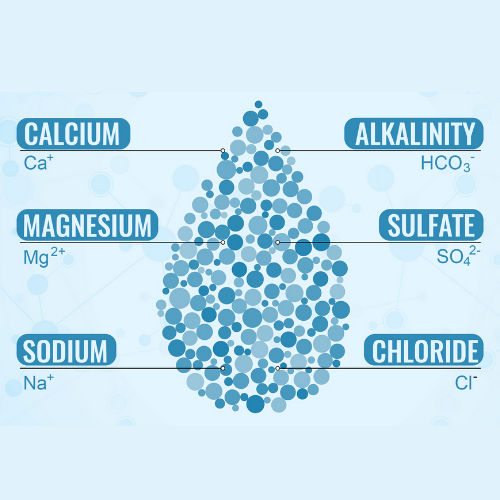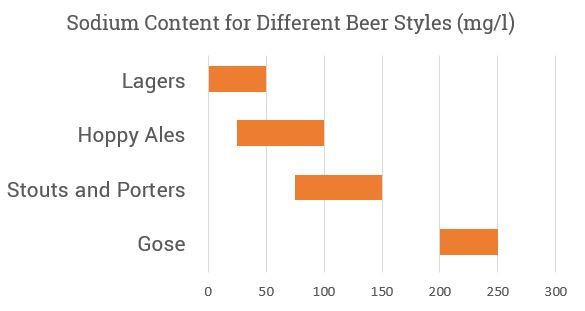Words by Jamie Carmichael
Brewers have long been aware of the importance of the minerals in water for the brewing process and the final taste and flavour of beer. Murphy & Son was founded on the principle of producing high quality water analysis and making the best possible recommendation for treatment by brewers.
Brewing water contains a multitude of ions, though the most important six are the three negative anions: alkalinity, sulfate and chloride and the positive cations: calcium, magnesium and sodium. The latter of which, sodium, is the highlight of today.
The taste of sodium is very familiar outside of beer – from seawater to seasoning of food with table salt – sodium chloride – where it is used to accentuate flavour. When adding table salt to food, the chloride ion is added in almost equal quantities – it’s usually regarded as the sodium doing most of the heavy lifting in food flavour. Substitution with salt substitutes like potassium chloride don’t work quite as well as the time served original. Though as discussed in further detail later, the presence of chloride is relatively more impactful in beer and should be considered when building up a water profile.

How much should be in beer?
Many of the same qualities can be seen in beer as in food with small amounts of sodium – an accentuation of sweetness, maltiness, roastiness, as well as the often cited means to give “palate fullness”. This makes it more appropriate to use additional sodium in darker, full-bodied styles like stouts and porters.
Around 100mg/l in brewing water is recommended for these styles. Beyond 150 mg/l the flavour can become unpalatable to some, and to most by 200mg/l where it causes a perceived sourness.
Gose – a traditional German Beer style provides a possible exception to the rule with sodium levels between 200 and 250 mg/l utilizing this sourness in conjunction with the acidity from warm, mixed fermentation, herbs and spices.
On the lower end, delicate beers like lagers and pilsners benefit from lower levels of sodium, below 50 mg/l.

Is sodium removed by the brewing process?
Not really. Although sodium is player in the membrane transport and osmoregulation of the yeast cell, only very small amounts are absorbed by the yeast and subsequently removed from the process prior to packaging.
Does my brewing water contain sodium?
Yes – The maximum allowed in municipal supplies around the UK is 200 mg/l. Though frequently the level is below 50 mg/l. Seasonal switching of supplies (e.g. from a reservoir to an aquifer) can make proportionally large swings in sodium concentration as it does the other ions.
Well water (particularly with proximity to the sea), treatment with water softeners or using sodium metabisulfite to remove chlorine can be the source of high levels of sodium in some areas –and may cause water to go above 200 mg/l sodium.
Do malt and hops add sodium?
Yes, though in practice very little. Through the process of drying and kilning the barley grains – malt contains “dehydrated water” and can increase the level of sodium in wort to a small extent, as do hops. The majority enters in by brewing water
How is Sodium concentration in water tested?
The low levels of sodium are detected to a high level of precision in our labs using inductively coupled plasma mass spectrometry.
As small concentrations of sodium can make big differences in the taste and flavour of your beer, it is important to get a reliable, accurate analysis of your brewing water with sodium. This is the first step to ensure that your beer will have neither too much nor too little sodium.
How does sodium work with the other ions to change flavour?
It is usually regarded that the chloride ion is the better counterpart to have in higher concentration in beers utilizing the qualities of sodium.
Higher levels of sulfate with sodium can introduce a harshness and sour taste. 50 mg/l sodium with 100 mg/l sulfate is usually the upper limit when together.
What products can I use to add sodium to beer?
In beer the addition of food grade sodium chloride can work well. This works synergistically to increase the sweetness of the beer which is beneficial to certain styles.
An understanding of the levels of all the ions is important when building a water profile. Sodium chloride is 40% sodium and 60% chloride by weight so the chloride level will increase proportionally faster with increasing additions of sodium chloride. Chloride has its own flavor threshold in beer – maxing out at 250 mg/l.
Even modestly hard water can contain appreciable levels of chloride. The application of calcium chloride to the mash will increase further. An addition of sodium chloride on top of that can push the beer over the chloride flavour threshold before the sodium does.
Other means to add sodium exist – sodium bicarbonate can be useful. The bicarbonate will increase pH of both the mash and beer. This can be useful if brewing dark styles where the roasted malts acidify but a higher final beer pH is preferred.
BYF No.3 Sodium Hydrogen Sulphate can help to increase the sodium content and lower the mash pH. Useful in beer styles like Gose or when alkalinity is in excess in brewing water.
Where should they be added?
Both sodium chloride and sodium bicarbonate easily dissolve and can be added at almost any point in the brewing process – from the brewing water to the finished product. There is no benefit to having the sodium present in the mash process like calcium.
Technical Expertise
We’re here to help. Murphy’s can perform an accurate liquor analysis with sodium, as well as provide unrivalled expertise in what liquor treatments, how much and where to add for your brewing process.
For more information, please email techsupport@murphyandson.co.uk

